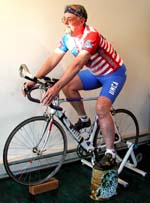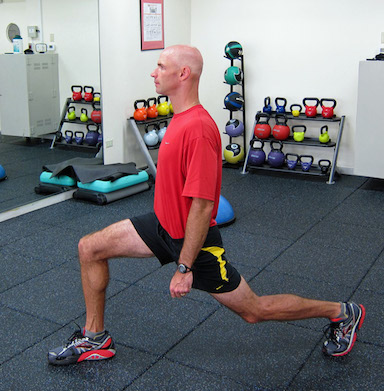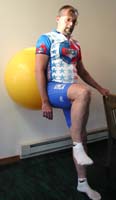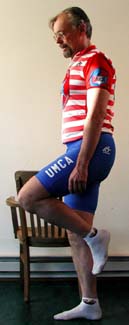 |
 |
 |
 |
 |
 |
 |
 |

|
 |
|
| |||||||||
|
Developing Leg Strength, Part 2 Strength Training for Century, Brevet and Other Endurance Cyclists by Coach John Hughes and Coach Dan Kehlenbach John Hughes and Dan Kehlenbach are the authors of Distance Cycling: Your Complete Guide to Endurance Cycling. Strength training overview for endurance cycling [ Part 1 | Part 2 ] Recommended exercises for
Developing Leg Strength
Two or three days a week, do three sets of 12-20 reps of one of the following strength exercises, which are progressively more difficult. For each of these exercises, the knee of the front leg should remain directly over the ankle—the knee should not go forward in front of the toes, which would place added stress on the knee. To build cycling-specific strength good exercise are: One-legged pedaling: Set the trainer to a moderately hard resistance and rest your left foot on a stool. Pedal 30—60 seconds with your right leg only at about 60 rpm. Then pedal 30—60 seconds with both legs. Don't bother to clip in, just rest your foot on the pedal and spin. Repeat this pattern several times and then switch legs. Each week, either increase the one-legged work interval or decrease the two-legged recovery interval.
Regardless of how routine riding a bicycle may become, a significant amount of balance and coordination is required to maintain an upright riding position. To improve unilateral force production, exercises that focus on single-leg control (single leg squats, step-ups, split squats and lunges) may be added to the overall program to provide an effective training stimulus. These exercises can be quite challenging—on a personal note, we have encountered many athletes who perform a leg press with hundreds of pounds, but lack the strength and control to perform a single leg squat. Placing the upper body in a cycling-specific position can further enhance exercises such as single-leg squats and step-ups. To improve balance and proprioception (joint awareness in space), several tools can be integrated into traditional resistance training exercises. Stability balls, foam pads (Airex), foam rollers, wobble boards and "Dyna-Discs" can provide the cyclist with an unstable training environment to enhance dys or decrease the two-legged rest intervals. Lunge: First master the split squat in Leg Strength Pt. 1, then proceed to the lunge. Step two to three feet forward with your right foot and lower left knee toward the floor. Go down until your right thigh is parallel to the floor. Keep your right knee over your ankle, not in front of your foot. Return to standing and repeat with left leg. Alternate R and L legs for each set. Strengthens quads, hams, and glutes. Start with no weights, and progress to holding a gallon of water in each hand.
Bosu Squat: Stand balancing on the curved side of the Bosu ball with your feet 12-15 inches apart. Squat down while maintaining balance and stand back up. Keep your knees over your feet; don’t let them bow in. Go down as far as you can while maintaining balance, but not more than a 90-degree bend in knees. Start with no weights, and progress to holding a gallon of water in each hand.
One-legged wall squats: Stand 8—12 inches away from a wall. Place a soccer/basketball between your lower back and the wall. Lift your left foot off the floor. Bend your right knee and, using the ball as a roller, squat down like you're sitting in a chair. Go down until your hip and knee joints form right angles (just like in a chair), then stand back up. Alternate sets of left and right legs.
One-legged squats: Stand near a door or hallway (something to lean on for balance) with a chair or stool behind you. Stand on your right leg, bend your left knee and rest your left toes on the chair. Squat down until your right thigh is about parallel with the floor.
Originally printed in UltraCycling |
|||||||||








